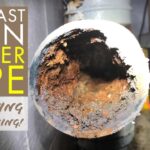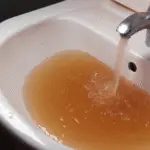Is your home experiencing drainage issues, unpleasant odors, or even water damage? If so, it might be time to take a closer look at your plumbing system.
Specifically, your cast iron sewer pipes could be rusted and leaking. These pipes, once the gold standard in plumbing, can deteriorate over time, leading to serious problems that can affect your entire household. Imagine waking up one morning to find water stains on your walls or floors, or worse, a foul smell that just won’t go away.
These are common signs that your cast iron sewer pipe is not just old but is causing trouble. But don’t worry—you’re not alone in this. Many homeowners face this exact issue, and the good news is, there are solutions available. We’ll dive into why cast iron sewer pipes rust and leak, how you can spot the warning signs early, and what steps you can take to fix or replace them. Understanding these aspects not only helps you tackle the problem head-on but also ensures that your home remains safe and comfortable. So, let’s get started and safeguard your home from plumbing mishaps.
Signs Of Rust And Leaks
Reddish-brown stains and water puddles can indicate rust and leaks in cast iron sewer pipes. These signs suggest corrosion, which weakens the pipe structure, leading to potential water damage. Regular inspections help in identifying such issues early.
Are you noticing unusual signs around your home that hint at potential plumbing problems? Cast iron sewer pipes, commonly used in older homes, can rust and leak over time, causing a host of issues. Identifying these signs early can save you from costly repairs and headaches. Let’s delve into the specific indicators that your cast iron sewer pipe might be rusted and leaking.Visible Corrosion
Corrosion is one of the most noticeable signs of a problem. If you see red or orange rust on the exterior of your pipes, it’s a clear warning. This corrosion weakens the pipe structure, leading to leaks. Regular inspections can help you catch this early before it escalates.Water Stains And Mold
Water stains on walls or ceilings can indicate a leaking pipe. Mold growth is another red flag, as moisture from leaks creates a perfect environment for mold. This can affect air quality and pose health risks. Look for discolored patches and a musty smell as key indicators.Foul Odors
A sewer-like smell in your home is more than just unpleasant; it’s a sign of a leak. When pipes corrode, sewer gases escape, causing foul odors. If you’ve ever entered a room and been hit by a strong, unpleasant smell, it might be time to check your pipes.Slow Drainage Issues
Are your sinks or toilets draining slower than usual? This might be due to rust buildup inside the pipes. Rust narrows the pipe’s diameter, obstructing water flow. If plunging doesn’t solve the problem, it could be a sign of deeper issues with your cast iron pipes. Addressing these signs promptly can prevent more serious damage. Have you noticed any of these issues in your home? Taking action early not only saves money but also ensures your home remains safe and comfortable.Causes Of Deterioration
Understanding why cast iron sewer pipes rust and leak is crucial for homeowners facing this issue. Deterioration can occur due to several factors, each contributing uniquely to the problem. Knowing these causes can help you decide whether repair or replacement is the best course of action for your home.
Age And Wear
Over time, cast iron pipes naturally degrade. They weren’t designed to last forever. A pipe installed decades ago may be nearing the end of its lifespan. Think of it as an old car—eventually, all the parts wear out. As the pipes age, they become susceptible to rust and leaks. Have you checked the age of your pipes lately?
Environmental Factors
The environment plays a significant role in pipe deterioration. If you live in an area with harsh weather conditions, your pipes might face more wear and tear. Moisture levels and soil composition can accelerate rusting. Consider how your local climate might be affecting your sewer system.
Chemical Reactions
Chemicals in sewage can react with the cast iron, leading to corrosion. These reactions weaken the pipe structure, causing leaks. Even household cleaners can contribute to this process. Could your cleaning products be speeding up pipe deterioration?
Improper Maintenance
Regular maintenance can prevent many issues, but neglect can lead to severe problems. Without routine checks, small issues can become big headaches. Ignoring signs like slow drainage might mean missing early warnings of pipe deterioration. Are you giving your sewer system the attention it needs?
Assessment And Inspection
Assessing and inspecting a rusted and leaking cast iron sewer pipe is crucial to prevent further damage to your home. Knowing when and how to inspect these pipes can save you time, money, and a lot of headaches. Whether you choose to hire a professional or take the DIY route, understanding the process is key to effective maintenance and repair.
Professional Inspection Services
Enlisting a professional inspection service can be a game-changer. Experts have the right tools and experience to detect even the smallest leaks and rust spots. A professional can provide a detailed assessment, often with a video inspection, allowing you to see the exact condition of your pipes.
They can identify issues that might not be visible to the untrained eye, helping you avoid potential disasters. Have you ever considered how much peace of mind a professional inspection could bring?
Diy Inspection Tips
If you’re a hands-on person, a DIY inspection might be up your alley. Start by examining the exposed areas of your cast iron pipes for any visible signs of rust or leaks. Listen for unusual sounds, like dripping or gurgling, which might indicate a problem.
Check for any unpleasant odors near your pipes, as these could be signs of a leak. Remember, safety first! Wear protective gloves and a mask to avoid contact with any hazardous materials.
Tools For Inspection
Having the right tools can make a significant difference in your inspection process. A flashlight is essential for seeing into dark, hard-to-reach places. A pipe inspection camera can give you a closer look inside your pipes without having to take them apart.
Moisture meters can help detect hidden leaks by measuring the moisture content in your walls and floors. With these tools in hand, you’re better equipped to make informed decisions about necessary repairs.
So, next time you find yourself facing a possible pipe issue, will you call in the professionals or trust your DIY skills? Either way, the right assessment and inspection can help you tackle the problem head-on.
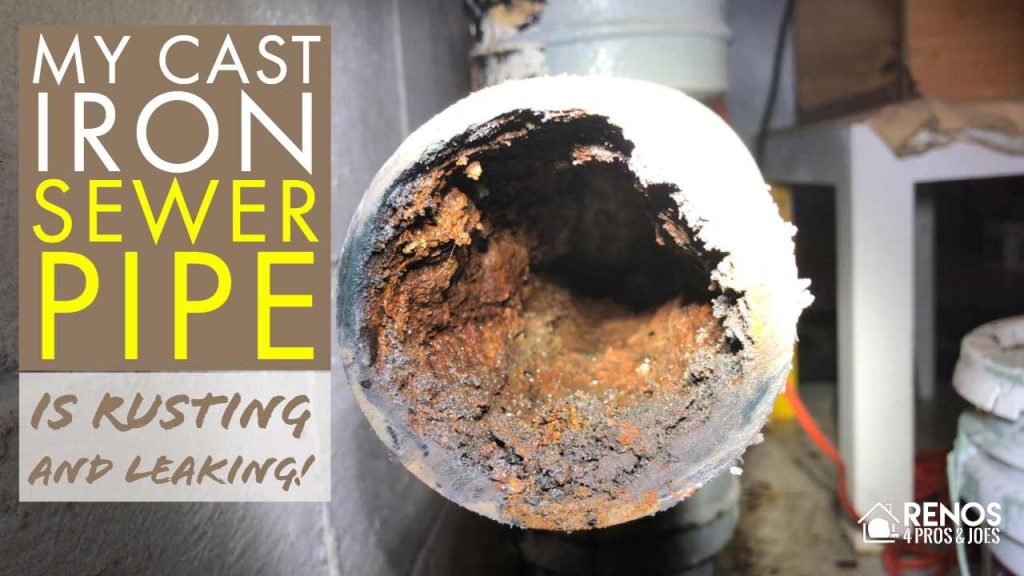
Credit: www.renos4prosandjoes.com
Repair Options
Rusted and leaking cast iron sewer pipes need attention. Replace damaged sections to prevent further issues. Alternatively, relining offers a durable solution by inserting a new pipe within the old one.
Dealing with a rusted and leaking cast iron sewer pipe can feel daunting, but understanding your repair options makes the process less stressful. Whether you’re facing minor leaks or a major overhaul, there are several effective solutions at your disposal. Let’s explore these repair options, which include pipe lining solutions, spot repairs, and pipe replacement considerations. Each choice has its own benefits and challenges, and knowing these can help you make an informed decision.Pipe Lining Solutions
Pipe lining is a modern method that fixes leaks without the need to replace the pipe entirely. This technique involves inserting a flexible liner coated with resin into the existing pipe. Once in place, the liner is inflated and cured, forming a new pipe within the old one. Imagine minimizing disruption in your home while extending the life of your sewer system. Pipe lining is especially useful if your pipes are hard to access or if you want to avoid the mess of digging. However, it’s essential to ensure that the pipe’s existing structure can support the lining for long-term success.Spot Repairs
If the damage is localized, spot repairs can be a cost-effective solution. This method involves fixing only the damaged section of the pipe. It’s like patching a hole in your favorite pair of jeans rather than buying a new pair. Spot repairs can be quicker and less expensive than other options, but they require precise identification of the problem areas. You’ll need a professional to assess whether this approach is feasible for your situation. Are the leaks small enough for a spot repair to be effective, or is there underlying damage that needs attention?Pipe Replacement Considerations
In some cases, replacing the entire pipe might be the best route. This option is usually necessary when pipes are extensively corroded or structurally compromised. While it might seem like a daunting task, replacing the pipes can provide peace of mind and a more permanent solution. Consider the age and overall condition of your sewer system. If your pipes have been causing frequent issues, replacement could save you time and money in the long run. Think about future-proofing your home. Wouldn’t it be better to address the problem fully now rather than facing ongoing repairs? Each of these options comes with its own set of benefits and potential drawbacks. Take your time, gather information, and consult with professionals to find the best solution for your specific situation. Your home deserves a sewer system that works efficiently and reliably.Preventive Measures
Cast iron sewer pipes can be a reliable part of your plumbing system. However, they have a tendency to rust and leak over time. Knowing how to prevent these issues can save you from costly repairs and potential damage to your home. Let’s look at some effective preventive measures.
Regular Maintenance
Regular maintenance is key to prolonging the life of your cast iron pipes. Just like you schedule routine check-ups with your doctor, make it a habit to inspect your pipes periodically. Look for signs of rust or leaks. Catching these early can prevent bigger problems down the line.
Consider setting a calendar reminder every few months to do a quick inspection. Sometimes, all it takes is a flashlight and a keen eye to spot potential trouble.
Use Of Protective Coatings
Protective coatings can serve as a shield against rust. Applying these coatings is like giving your pipes a coat of armor. It helps keep moisture at bay and reduces the risk of corrosion.
Have you ever seen a car with a fresh coat of wax? It gleams and seems almost impervious to the elements. That’s the kind of protection you want for your pipes. Make sure to choose coatings specifically designed for cast iron to ensure maximum effectiveness.
Water Quality Management
The quality of water running through your pipes can significantly impact their longevity. Hard water, for example, can accelerate rusting. You might not think about your water quality often, but it plays a crucial role in pipe maintenance.
Consider investing in a water softener if your water is hard. It’s a small change that can make a big difference. You’ll not only extend the life of your pipes but also enjoy better water quality throughout your home.
Have you ever wondered why some homes experience more plumbing issues than others? It often boils down to preventive measures. What steps are you taking to ensure your cast iron pipes stay in good condition?
Cost Considerations
Dealing with rusted and leaking cast iron sewer pipes is costly. Understanding cost considerations helps homeowners make informed decisions. Key factors include repair versus replacement costs, long-term savings, insurance, and warranties.
Repair Vs Replacement Costs
Repairing a cast iron sewer pipe is often cheaper initially. It involves patching leaks or using liners. But repairs may not last long. Replacement involves installing new pipes. It can be more expensive upfront. However, it reduces the risk of future problems. Weighing costs helps decide the best option for your budget.
Long-term Savings
Investing in replacement offers long-term benefits. New pipes require less maintenance. They also prevent recurring leaks. This reduces future repair costs. It also adds value to your property. Choosing replacement now saves money over time.
Insurance And Warranties
Check your home insurance policy. Some policies cover sewer pipe issues. This helps reduce out-of-pocket expenses. Warranties on repairs or replacements provide extra protection. They ensure quality work. Understanding insurance and warranties aids in cost planning. It also provides peace of mind.
When To Call A Professional
Rust and leaks in cast iron sewer pipes signal the need for expert help. Timely intervention prevents costly repairs. Professionals efficiently address these issues, ensuring long-lasting solutions.
When dealing with a rusted and leaking cast iron sewer pipe, the question often arises: Is it time to call in a professional? While minor repairs might be within your DIY capabilities, certain situations demand the expertise of a qualified plumber. Knowing when to seek professional help not only saves you time and effort but also prevents potential disasters. Let’s dive into the specific scenarios where calling a professional is your best bet.Severe Damage Signs
When you notice extensive rusting, cracks, or significant leaks, it’s a red flag. These severe damage signs indicate that the pipe might be beyond a simple patch-up. A friend once ignored these signs and ended up with a flooded basement. Don’t let that be your story. Professionals have the tools and experience to assess the damage accurately and recommend the best course of action.Complex Repair Needs
Some repairs are not straightforward. If your sewer line runs under concrete floors or behind walls, accessing it can be a complex task. Attempting this on your own can lead to more damage. Would you risk breaking a perfectly good wall just to patch a pipe? Experts can navigate these challenges with minimal disruption to your home.Emergency Situations
Imagine waking up to the pungent smell of sewage or finding your yard flooded with waste. These are emergency situations where waiting is not an option. Quick action is crucial to prevent further damage and health risks. Calling a professional ensures that the issue is addressed promptly and effectively. They are equipped to handle emergencies, giving you peace of mind. In any of these scenarios, the cost of hiring a professional can be outweighed by the potential damage of delaying the repair. Always consider the long-term implications of a quick fix versus a lasting solution. Have you ever faced a plumbing issue that spiraled out of control because you waited too long to call for help? Let this guide you in making the right decision for your home.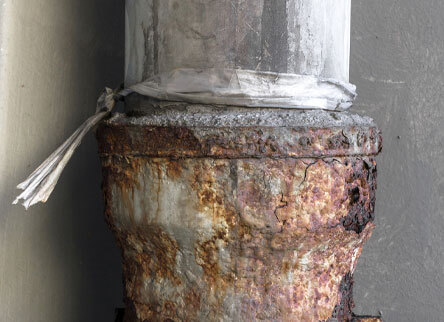
Credit: newflowplumbing.com
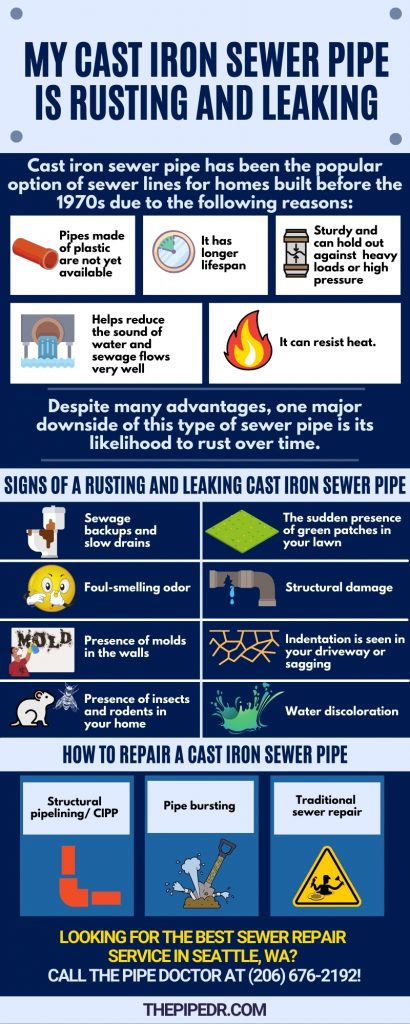
Credit: thepipedr.com
Frequently Asked Questions
How Can I Identify A Rusted Sewer Pipe?
Look for discolored water. Check for leaks or unusual smells near pipes. Listen for strange noises.
Why Is My Cast Iron Pipe Leaking?
Rust creates holes in pipes. Pipes can crack due to pressure. Old pipes are more likely to leak.
Can Rusted Pipes Be Repaired?
Yes, minor rust can be fixed. Patching or epoxy lining are options. Severe rust may need pipe replacement.
What Are Signs Of Pipe Rust?
Orange or brown stains are common. Flaky surface or rough texture indicates rust. Water pressure changes may occur.
How Often Should Pipes Be Checked?
Annually is ideal. Older homes may need more frequent checks. Regular inspections prevent major problems.
Conclusion
Rusted cast iron pipes can cause big problems. Leaks can damage your home. Fix them soon to avoid costly repairs. Regular inspections help catch issues early. Newer materials offer better durability and less rust. Consider replacing old pipes for peace of mind.
Always consult a professional for advice. They ensure repairs meet local codes. Protect your home and save money in the long run. Act now to avoid bigger issues later. A well-maintained plumbing system is vital for safety and comfort. Keep your home’s foundation strong and secure.



